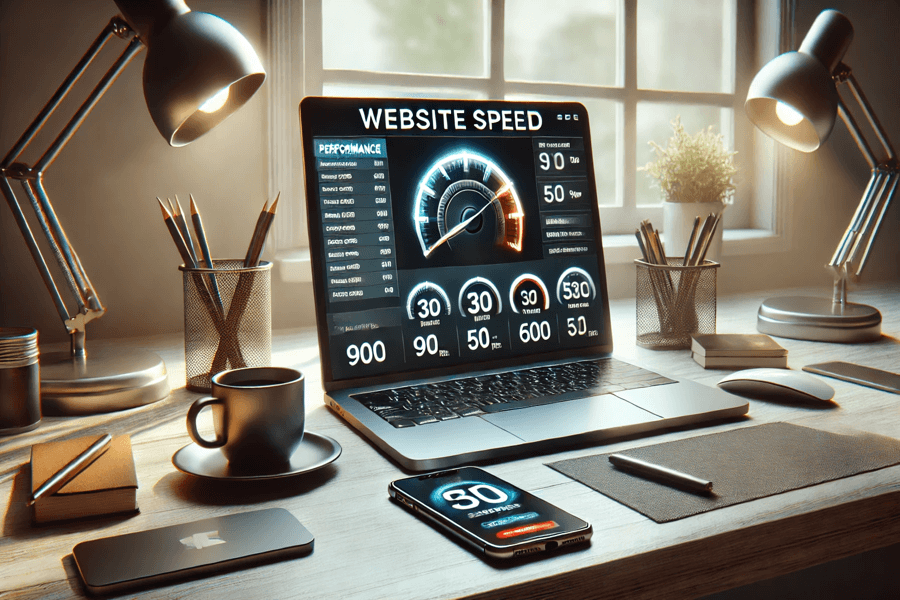Did you know that your website’s speed can make or break your online success? Slow websites frustrate visitors, lead to higher bounce rates, and, worst of all, hurt your search engine rankings. If you’re a beginner or a business owner looking to boost your website’s performance, you’re in the right place.
Let’s explore why speed matters and the actionable steps you can take to improve it.
Why Website Speed Matters for SEO
Search engines like Google prioritize fast-loading websites because they offer a better user experience. Here’s why speed is critical:
- User Experience: A website that loads in under 2 seconds keeps users happy. A delay of just 1 second can reduce conversions by up to 7%.
- Search Rankings: Google has made page speed a ranking factor for both desktop and mobile searches.
- Mobile Traffic: With the majority of traffic coming from mobile devices, a slow site means users will quickly leave.
How to Check Your Website’s Speed
Before making improvements, you need to know where you stand. Here are some tools to get started:
- Google PageSpeed Insights (free): Provides a speed score and suggestions for improvement.
- GTmetrix (free and premium): Gives a detailed breakdown of performance issues.
- Pingdom (free and premium): Focuses on loading times and areas to optimize.
Pro Tip: Test both desktop and mobile speeds to ensure a smooth experience across devices.
Simple Steps to Improve Website Speed
If you’re new to SEO, here’s a beginner-friendly plan to start improving your website’s speed:
1. Optimize Images
Large image files are one of the biggest culprits behind slow websites.
- Use tools like TinyPNG or ImageOptim to compress images without losing quality.
- Save images in modern formats like WebP, which are smaller in size compared to JPEG or PNG.
- Resize images to match the dimensions they’ll be displayed in.
Example: If your website displays images at 800×600 px, don’t upload a 3000×2000 px file.
2. Enable Browser Caching
Browser caching stores website data (like images, CSS, and JavaScript) on a visitor’s device, so pages load faster on repeat visits.
- If you’re using WordPress, install a plugin like W3 Total Cache or WP Rocket to handle caching automatically.
3. Minify CSS, JavaScript, and HTML
“Minify” means removing unnecessary spaces, comments, and characters from your code to make it lighter and faster.
- Tools like Autoptimize (WordPress plugin) or Minify Code (online tool) can do this for you.
4. Use a Content Delivery Network (CDN)
A CDN stores copies of your website on servers around the world, reducing the time it takes to load your site for users in different locations.
- Popular CDNs include Cloudflare, Akamai, and StackPath.
- Most CDNs also offer free plans for small websites.
5. Reduce Server Response Time
Your server’s speed plays a big role in how quickly your website loads.
- Choose a reliable hosting provider that offers optimized servers for performance.
- If you’re on shared hosting, consider upgrading to a VPS or dedicated server for better speed.
6. Lazy Load Images and Videos
Lazy loading ensures that images and videos are loaded only when they come into view, saving resources and improving speed.
- For WordPress, use plugins like Smush or Lazy Load by WP Rocket.
- For custom websites, implement lazy loading using JavaScript or libraries like lazysizes.
Need Help with Your Website Speed?
Improving website speed can feel overwhelming, especially if you’re not sure where to start or don’t have the technical expertise. That’s where I come in!
I specialize in helping businesses like yours optimize their websites for speed, ensuring faster load times, better rankings, and happier visitors. Whether it’s image optimization, advanced caching, or server tweaks, I can take care of it for you.
Reach out today, and let’s get your website blazing fast!
Common Mistakes to Avoid
- Ignoring Mobile Optimization: Always check mobile speed separately. Slow mobile performance can hurt rankings more than desktop issues.
- Overloading Plugins: Using too many plugins can slow down your site. Stick to essential plugins only.
- Not Monitoring Speed Regularly: Website performance can degrade over time. Regularly test your speed to stay ahead.
Track Your Progress
Once you’ve made improvements, use the tools mentioned earlier to track your progress. Pay attention to:
- Loading time (aim for under 2 seconds).
- Speed scores (a Google PageSpeed score above 85 is a good target).
- Bounce rate (a lower bounce rate indicates happier visitors).
Final Thoughts
Improving your website speed doesn’t just help with rankings; it creates a better experience for your visitors, keeps them engaged, and ultimately boosts your business. Start small with the steps we’ve discussed, like optimizing images and enabling caching, and build up to more advanced techniques like lazy loading and using a CDN.
If you’re looking for someone to handle it all for you, let me help! With my expertise, you’ll get a faster website, higher rankings, and more satisfied users.
So, what are you waiting for? Let’s get your website blazing fast today!

